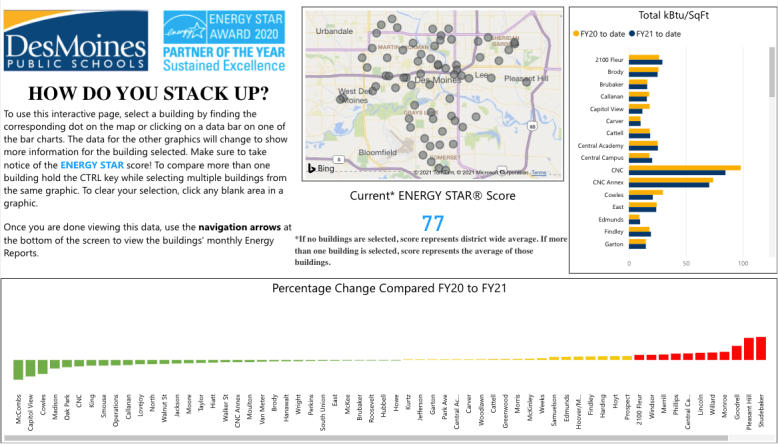
9-Year ENERGY STAR Award Winner Des Moines Public Schools Uses Energy Manager for $20M+ in Savings
Background
It’s no easy feat managing the energy and utility use for 70 buildings – so imagine doing that and earning award-winning status?
For Des Moines Public Schools (DMPS), it’s all in a day’s work managing energy with the help of Energy Manager. After all, they have benchmarked 68 district buildings, 60 are eligible for ENERGY STAR certification; they have 42 geothermal buildings; and they’re a 100% LED district. Not too bad for a district with buildings that are, on average, 65 years old.
Since 2009, they have decreased their energy use intensity by 31%. Since 2008, they have saved more than $20.2 million and prevented 40,600 metric tons of CO2 emissions with their conservation efforts.

A snapshot of Des Moines Public Schools’ energy savings from 2009-2020
Tyler Puls, Energy & Environmental Specialist, equates their success and 9-year streak (2012-2020) of winning the ENERGY STAR Partner of the Year Award for Energy Management to a combination of communication and technology.
Communicating updates & successes
For them, communication comes in the form of:
- An energy team within the facilities department that meets monthly to discuss current projects and progress
- Energy Report Cards they release several times a year with updates and data on ratings and savings from Energy Manager
- A monthly newsletter distributed with energy-saving tips to be used in the classroom and other areas
“We’ve found [the Energy Report Card] to be a good communication piece and make it somewhat of a competition,” Tyler says. “We try to go through each building and evaluate on a monthly scale where our increases and decreases in energy usage are and compare to the previous year.”

An example from a recent Energy Report Card
How software empowers energy saving
Tyler says they use Energy Manager to record data and to prove needs and savings.
“We use Energy Manager as a concise place that has all our data. Spreadsheets and things like that are difficult to manage. Having everything in one spot has proven to be a valuable thing for us. It allows us to quickly understand our utility usage and costs.”
And when they can better understand their costs, they can more easily control and share them.
“It makes it easier to justify all the costs that we’re spending,” Tyler says.
It makes it easier to look at our energy usage and the money we’ve saved there.


Learn more about this integration.
Savings are important since they typically have a budget deficit every year and are always looking for ways to cut down – and energy conservation makes a difference.
“If we can save utility dollars, it directly relates to the ability to hire additional staff and provide resources for students,” he says.
And the numbers speak for themselves:
- DMPS spent an average of $124 per student on energy costs in 2020, which is significantly lower than the national average of $205 per student
- Their energy expense savings in 2020 compared to 2019 equate to 15 new teacher salaries
- The Council of the Great City Schools currently ranks DMPS third out of 77 for energy costs per square foot
Importance of ENERGY STAR ratings
ENERGY STAR has been important for several years at Des Moines. Tyler says it became important initially to justify their energy project budget. And it continues to be critical as they rely on renovating their aging buildings vs. building new. And their high scores and awards show that they’re doing the right thing.
“ENERGY STAR is a valuable tool to show that we’re putting in the work to manage this properly,” Tyler says.
They will continue to use their ENERGY STAR ratings and tracking capabilities in Energy Manager as they look to the future, implementing programs like installing solar panels. And, with the help of Elementary and Secondary School Emergency Relief (ESSER) funds, the district will be upgrading their HVAC systems to prioritize indoor air quality (IAQ) throughout their facilities
Results
9-year winner of the EPA’s ENERGY STAR® Partner of the Year Award
31% decrease in energy use intensity over 11 years
$20 million saved and 40K metric tons of CO2 emissions prevented since 2008
100% LED district
Vitals
70 facilities and 6.1 million sq. feet managed

